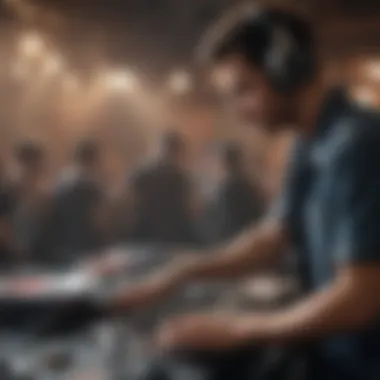Exploring the Role of a DJ in Modern Music Culture


Intro
In today’s dynamic music environment, the role of a DJ transcends mere entertainment. DJs are often the heartbeat of live performances, curating unique sound experiences that resonate with audiences. This article will explore the intricate aspects of a DJ's role, focusing on their technical skills, the evolution of their craft, and the profound connection they forge with audiences. By analyzing various styles and techniques, we aim to provide insights that can inspire and guide aspiring DJs.
Artist Profile
Biography and Background
The journey of a DJ typically begins in their formative years. Many start as music enthusiasts, uncovering genres and artists that shape their early musical tastes. Over time, a passion for music intertwines with a desire to perform, leading them to experiment with DJ equipment. Understanding the craft requires not just technical skill but also a deep appreciation for music history and trends.
Major Influences and Inspirations
DJs often cite a range of artists and genres that influence their style.
- House music: Known for its rhythmic beats, it provides a backbone for many DJs' sets.
- Hip-hop: The art of mixing and scratching here inspires creativity and flair.
- Electronic music: Pioneers in this genre impact modern techniques and production methods.
These influences result in a unique blend that defines each DJ’s sound and approach.
Technical Aspects of DJing
Equipment and Software
DJs harness various tools to create an immersive sound experience. The equipment involves turntables, mixers, and digital audio workstations like Serato or Traktor. Understanding how to use these effectively is essential for any DJ.
Mixing Techniques
Mixing is an art in itself. DJs employ several techniques to achieve seamless transitions. This includes:
- Beatmatching: Aligning the beats of two tracks.
- Crossfading: Smoothly transitioning from one track to another.
- Looping: Repeating a section to enhance flow.
Through mastering these techniques, DJs elevate live performances, making each set unique.
The Evolution of DJing
The art of DJing has changed dramatically since its inception. In the past, DJs primarily spun vinyl records. Today, technology has transformed the landscape. Digital platforms allow for a wider selection of music and enhanced creativity. This evolution has opened doors for new styles and methods of engagement, pushing boundaries further.
Relationship with the Audience
DJs create an interactive experience. Their success often relies on gauging audience reactions. Understanding the crowd’s mood can inform track selection.
"A DJ's ability to connect with the audience is what turns a good set into a memorable experience."
Engaging with the audience, whether through live remixes or well-timed drops, is crucial for creating an memorable event.
Ending
In summary, the multifaceted role of a DJ encompasses technical skills, audience engagement, and a deep understanding of music culture. As technology continues to evolve, so does the craft of DJing. Aspiring DJs should focus on cultivating their unique sound while honing their skills. By doing so, they can contribute to the rich tapestry of contemporary music culture.
Understanding the DJ's Role
In the contemporary landscape of music, DJs hold a unique and pivotal position. They are not mere players of records; rather, they are curators of sound, shaping the auditory experiences of their audience. Understanding the DJ's role encompasses several elements—their skills, the cultural significance, and the technological advancements that have transformed how we perceive music today. Recognizing these aspects facilitates a deeper appreciation for their craft.
Defining the DJ
A DJ, short for disc jockey, is an individual who selects and plays recorded music for an audience. The core function may seem simple, yet it involves a vast range of skills and knowledge in music selection, mixing, and audience engagement. The DJ often operates different types of equipment to manipulate sound, creating a unique mix that resonates with the crowd. Successful DJs harness their understanding of music and rhythm to maintain energy levels and evoke emotional responses through their sets. This skill set distinguishes a DJ from a mere playlist curator.
The Evolution of DJing
The journey of DJing reflects broader technological and cultural shifts in the music industry. Over the decades, methods and practices have significantly changed.
From Mixers to Modern Technology
The evolution from basic mixers to advanced digital technology marks a significant milestone in DJing. Initially, DJs relied on mixers to blend tracks seamlessly. However, modern technology introduced digital audio workstations, which allow for more intricate mixing capabilities. Digital technology has also facilitated wider access to extensive music libraries, effectively changing how DJs source and curate music. This accessibility enhances their ability to craft diverse and customized sound experiences.
The Transition from Vinyl to Digital
The shift from vinyl to digital formats has revolutionized the way DJs perform. Vinyl records were once the standard, requiring particular skills like beatmatching. Today, digital formats, like MP3 and WAV, provide ease of use and manipulation. DJs can load an entire library onto a single device, significantly lowering the physical burden of carrying records. While vinyl holds a nostalgic and tactile quality, digital formats offer more flexibility, altering the landscape of DJing. This transition has opened the door for aspiring DJs to enter the field without the logistical complications once faced.
The DJ's Cultural Significance
DJs do not only influence the music being played; they shape music culture as a whole. Their impact reverberates across communities and genres, forging connections through rhythm and sound.
Influence on Music Genres
The role of DJs has been instrumental in the development of several music genres like house, techno, and hip hop. By remixing and blending tracks, they continually push the boundaries of existing genres, thus fostering innovation. DJs play an essential part in introducing new sounds to audiences that eventually become staples in the industry. This continuous evolution demonstrates their profound influence on music.
Creating Community through Music


DJs have a unique ability to create a sense of community among fans. Events and performances often serve as social gatherings where individuals unite, creating shared experiences that are memorable and lasting. The communal aspect of music brings people together, transcending geographical limitations. Through their sets, DJs craft atmospheres that promote connection and joy, highlighting their role not only as entertainers but also as facilitators of social interaction.
Technical Skills Required for DJs
Understanding the technical skills necessary for DJs is fundamental in grasping the essence of their craft. DJs are not just playing music; they are curating experiences. The skill set required spans various dimensions, from equipment proficiency to advanced mixing techniques. Mastering these skills not only enhances a DJ's performance but also ensures that audiences remain engaged and entertained.
Essential DJ Equipment
Turntables and Mixers
Turntables and mixers serve as the backbone of traditional DJ setups. Their significance lies in the tactile interaction they offer, allowing DJs to manipulate sound physically. A key characteristic of turntables is their ability to play vinyl records, which is sought after for its warm sound quality. For many, the act of spinning records is an art form that evokes nostalgia. Turntables are also sturdy, making them a reliable choice for both practicing at home and performing in live settings.
The unique feature of mixers is their capability to blend multiple audio sources seamlessly. This mixing ability facilitates transitions between songs, maintaining the energy on the dance floor. However, the complexity in using a mixer can be overwhelming for beginners. Therefore, understanding signal flow and effects becomes essential to leverage its full potential effectively.
Digital Audio Workstations
Digital Audio Workstations, or DAWs, further broaden a DJ's toolbox, accommodating creative possibilities beyond traditional setups. A defining characteristic of DAWs is their versatility. They not only allow recording and mixing but also offer extensive options for editing and sound design. Software like Ableton Live and Serato DJ is extremely popular among DJs for their intuitive interfaces and powerful capabilities.
A notable advantage of DAWs is accessibility—aspiring DJs can start creating mixes right from their laptops without significant investments. However, relying solely on digital tools might distance some from the foundational skills of DJing. Critical thinking and creativity are crucial to find a balance between technology use and hands-on techniques.
Mixing Techniques
Beatmatching
Beatmatching is the cornerstone of a DJ's skill set. This technique involves aligning the tempo and phase of two tracks to ensure a seamless transition. The primary characteristic of beatmatching is its emphasis on synchronization. This skill adds a professional touch to a set, keeping the energy consistent and the audience engaged.
In terms of benefits, beatmatching cultivates a deep understanding of musical structure. It encourages DJs to listen actively and develop a more refined ear for rhythm. However, as digital tools evolve, some argue that reliance on automatic syncing features may diminish the necessity for this skill. Nonetheless, mastering beatmatching remains invaluable for any serious DJ.
EQing and Effects
EQing and effects processing are crucial components of mixing that enhance sound quality and create unique sonic textures. The key characteristic of EQing is its capacity to adjust the balance of frequencies in a track. Effective use of EQ allows DJs to eliminate muddiness and highlight essential elements of each song.
The use of effects can elevate a performance by adding depth and uniqueness. Effects like reverb, delay, or filters can manipulate how a track feels, mesmerising audiences and creating memorable moments. However, misuse of effects can lead to a cluttered sound. A DJ must strategize their use of EQ and effects carefully to maintain clarity while achieving creativity.
Preparing a Setlist
Understanding Audience Dynamics
A successful DJ must grasp audience dynamics intimately. This understanding entails recognizing how a crowd reacts, and then determining the appropriate musical response. The key characteristic of understanding audience dynamics is adaptability. A DJ not only plays music but actively observes and tailors their set based on the energy in the room.
The ability to read the crowd effectively can be beneficial for curating a set that resonates deeply. A responsive approach helps foster a connection between the DJ and the audience, leading to a more engaging experience. However, crowd reading is subjective and can vary widely based on different musical genres and event types.
Creating a Flow
Creating a flow involves arranging track sequences in a way that maintains energy and keeps the audience engaged throughout the performance. The importance of flow lies in its ability to create a narrative through music, leading listeners on a journey. A cohesive flow encourages dancing and enjoyment, enhancing the overall vibe.
A unique feature of creating flow is the strategic placement of climaxes and softer moments within a set. This thoughtful design keeps the audience captivated and emotionally invested. However, over-planning can lead to rigidity, and thus a balance between structure and spontaneity is critical in maintaining a vibrant atmosphere.
Performance Aspects of DJing
Performance aspects of DJing are central to the overall impact a DJ has on an event. This includes how the DJ interacts with the audience, creates an immersive atmosphere, and collaborates with other artists. Each component not only enhances the musical experience but also fosters a connection between the DJ and the audience, making the event memorable.
Engaging with the Audience
Reading the Crowd
Reading the crowd is a crucial skill for any successful DJ. It involves being aware of the audience's energy and mood. A DJ who can read the crowd effectively can adapt their setlist to match the vibe. This skill is pivotal because it ensures that the music resonates with the audience. The key characteristic of reading the crowd is attentiveness. A good DJ observes reactions closely. This creates an engaging experience and helps in maintaining energy levels throughout the event.
The unique feature of reading the crowd lies in its fluid nature. What works in one moment may not in another. Hence, DJs must be flexible and ready to shift gears if necessary. The advantage here is that it fosters a connection with the audience. However, the downside is that it can create pressure on the DJ, as they must make quick decisions based on real-time feedback.
Utilizing Visuals
Utilizing visuals enhances the auditory experience by adding a visual dimension to the performance. This can include lights, videos, or even projections that complement the music. The key characteristic of this approach is its ability to create a multi-sensory experience. This makes the event more appealing and memorable. For this reason, incorporating visuals is beneficial in enhancing the overall entertainment value of an event.
A unique feature of utilizing visuals is the synchronization between music and display. When both elements work in harmony, it amplifies the audience's engagement. The advantage is that it captivates attention and immerses attendees in the performance. However, the downside might be the additional complexity of coordinating visuals, which could distract from the music.
Building the Atmosphere
Incorporating Lighting
Incorporating lighting is a fundamental aspect of a DJ's performance that contributes significantly to the overall atmosphere. Different lighting techniques can evoke various emotions and energize the crowd. The key characteristic of this aspect is how lighting sets the mood for the event. This makes it an advantageous choice for any DJ looking to elevate their performance.
The unique feature here is the ability to change lighting in response to music dynamics. Adjusting brightness and color can enhance peaks in a set, creating an immersive experience. The advantages include creating a more engaging and energetic atmosphere. The possible disadvantage, however, is that poor implementation can disrupt the flow, potentially detracting from the music itself.
Creating a Unique Experience
Creating a unique experience is essential for distinguishing one DJ from another. This involves integrating various elements like personal style, setlists, and engagement strategies. The key characteristic of this aspect is the originality that a DJ brings to their set. This makes this choice popular among aspiring DJs who seek to leave a lasting impression.


A unique feature of creating a unique experience is the incorporation of unexpected elements into a set, like mashups or exclusive remixes. This can captivate the audience and keep them intrigued. The advantages are clear: a memorable event can lead to repeat bookings and a loyal fan base. The downside lies in the potential risks taken; if something doesn’t work, it could impact the set negatively.
Collaboration with Other Artists
Working with Vocalists
Working with vocalists adds depth to a DJ's performance. Collaborating on original tracks or remixes can bring a fresh dynamic. The key characteristic here is the blend of musical styles. This is a beneficial aspect as it can attract a diverse audience and introduce variations to the sound.
A unique feature of this collaboration is how it allows for improvisation and spontaneity during live performances. This can enhance the artistic expression and emotional connection with the audience. However, a potential disadvantage could be the challenge of coordinating schedules and ensuring that all artists are on the same page when preparing for a gig.
Joint Performances with Live Musicians
Joint performances with live musicians can create an unparalleled experience. The integration of instruments with DJ sets offers a unique blend of live and electronic music. The key characteristic of this performance aspect is versatility. It allows for creative interpretations and new arrangements of common tracks. This can generate a fun and exciting option for audiences.
A unique feature of these collaborations is the spontaneity that arises from live interactions. It can lead to unexpected moments of magic, captivating the audience. The advantages include a richer musical experience and the ability to stand out in a competitive field. However, the challenge lies in the complexity of managing different musicians and aligning various styles, which could complicate the performance.
Genres and Styles of DJing
The exploration of genres and styles of DJing is essential for understanding the dynamic world of DJs. Each genre offers a unique rhythm, pacing, and cultural significance. DJs not only shape the sound at events but also reflect the broader cultural movements that these genres signify. Knowing about different styles aids DJs in creating diverse sets, appealing to varied audiences, and enhancing overall performance quality. This deep dive includes the significance of house music, techno, minimalism, and hip hop culture, indicating how they contribute to the DJ's toolkit for crafting memorable experiences.
House Music and its Variants
House music, originating in the early 1980s, is characterized by repetitive four-on-the-floor beats and off-beat hi-hat cymbals. Understanding house music is crucial for any DJ, as it forms a foundation for many other electronic genres. Variants like deep house and progressive house offer a palette of sounds that can cater to different moods and settings. DJs must recognize the nuances of these styles, as it improves their ability to craft a set that aligns with audience expectations.
Key elements of house music include:
- Groovy Basslines: A defining feature that makes house tracks danceable.
- Melodic Hooks: Catchy tunes that engage listeners, fostering memorability.
- Vocal Elements: Often present in various sub-genres, they create emotional connections with the audience.
By mastering these elements, DJs can manipulate energy levels and ensure a smooth flow among tracks.
Techno and Minimalism
Techno, which emerged from Detroit in the mid-1980s, embodies a futuristic sound that emphasizes innovation. It often features a steady beat and synthesized sounds, creating a hypnotic atmosphere. In contrast, minimalism within techno strips down complexity, focusing on rhythm and subtle shifts in sound. This genre challenges DJs to curate sets that maintain intensity despite fewer elements, which can be particularly powerful in live settings.
Important characteristics of techno and minimalism include:
- Driving Beat: Often faster and less melodic, presenting a trance-like experience.
- Sound Design: Heavy reliance on synthesizers and effects, requiring technical skill in mixing.
- Sustainability: The artistry lies in sustaining the crowd's energy while allowing the music’s minimal nature to resonate.
DJs can explore this genre to showcase their mixing finesse and embrace a more avant-garde approach to performance.
Hip Hop DJ Culture
Hip hop DJ culture is multifaceted, spanning decades and incorporating distinct techniques that are integral to its identity. From turntablism, which involves skillful manipulation of records, to beat juggling and scratching, hip hop DJs have played a pivotal role in shaping the genre’s sound. Understanding this culture involves recognizing its importance in community building and social expression.
Major components define hip hop DJing, including:
- Sampling: The use of snippets from existing tracks to create new experiences.
- Freestyling: Allowing spontaneity, enabling DJs to respond and adapt to the crowd's energy.
- Cultural Impact: Hip hop DJs often engage with community issues, serving as voice for the unheard.
This style emphasizes the relationship between the DJ, the music, and the audience. It highlights the role of a DJ as not just a performer, but also as a storyteller and cultural ambassador.
In summary, the genres and styles of DJing are integral to the craft. Understanding these elements allows DJs to navigate their sets effectively, maintain audience engagement, and participate in the evolving music dialogue.
DJs who master various genres can enhance their versatility and adaptability in a competitive music landscape.
The Impact of Technology on DJing
The role of technology in DJing cannot be overstated. It has fundamentally transformed the way DJs operate, perform, and interact with their audiences. At its core, technological advancements have simplified the technical aspects of DJing, allowing for deeper creativity and greater flexibility. This influence can be examined through the lens of software advancements and the rise of live streaming.
Software Advancements
Digital Mixing Software
Digital mixing software is a cornerstone of modern DJing. This type of software allows DJs to manipulate audio tracks with precision that was previously unattainable. A key characteristic of digital mixing software is its user-friendly interface. Programs like Serato DJ, Traktor Pro, and Virtual DJ have become quite popular because they provide intuitive controls that enable DJs to focus more on their creativity rather than the technical hurdles.
Unique features such as built-in effects, looping capabilities, and real-time waveforms enhance the mixing experience. However, one must consider potential drawbacks, like system instability during live performances. This consideration is crucial because software updates or system failures can interrupt a DJ’s set, leading to disappointing experiences for the audience.
Sampling Techniques
Sampling techniques also play a significant role in how DJs create new music. This process allows DJs to incorporate fragments of existing songs into their mixes, lending a new texture to their sound. The key characteristic of sampling techniques is versatility. They permit DJs to craft unique sounds by blending various music pieces.
One unique feature of sampling is the ability to manipulate samples in real-time, allowing a DJ to adapt their performance dynamically. However, this can lead to issues related to copyright infringement, as using samples without permission can cause legal complications. Despite these challenges, sampling remains a vital skill for many in the DJ community, driving innovation in their work.
The Rise of Live Streaming
Platforms for Online DJ Sets
Platforms for online DJ sets have surged in popularity, especially in recent years. Services like Twitch and Mixcloud have created avenues for DJs to reach global audiences without the constraints of physical venues. These platforms facilitate the sharing of music and performances, broadening the reach of artists significantly.


A key factor that makes these platforms appealing is their ability to engage diverse audiences. DJs can perform live from anywhere. However, one challenge is the potential competition from countless other DJs, making standout branding essential to success.
Engaging Global Audiences
Engaging global audiences is another significant aspect of live streaming. It allows DJs to share their music with fans from different countries and cultures seamlessly. This global reach provides opportunities for collaboration and interaction that were previously limited to local scenes.
A unique feature of engaging global audiences is the interactive capability of live platforms. Audiences can actively participate through chats and comments, offering real-time feedback. However, this can also lead to distractions during performances, requiring DJs to carefully balance their focus between mixing and audience engagement.
In summary, technology has altered the DJing landscape. From software advancements to the rise of live streaming, each aspect contributes to crafting a richer sound experience for audiences worldwide. Understanding these tools and techniques is crucial for any aspiring DJ.
Establishing a DJ Career
Establishing a career as a DJ is essential for any aspiring music professional. It combines personal branding with a deep understanding of the music industry. This blend helps DJs who want to create memorable experiences for their audiences. A successful career requires not just talent but also strategic planning and savvy business knowledge. Moving beyond mere passion, DJs must navigate the competitive landscape of the industry.
Building a Personal Brand
The concept of building a personal brand is foundational for a DJ's career. It involves creating an identity that resonates with audiences and sets one apart from others. A strong personal brand generates recognition and fosters loyalty among fans.
Social Media Presence
Social media presence is crucial in today's digital age. It allows DJs to connect directly with their audience. Platforms like Instagram, Facebook, and Twitter enable DJs to share their work, announce events, and engage their followers. The key characteristic of social media is its immediacy. Users can share experiences in real-time, making it a dynamic tool for communication.
- Advantages:
Social media can amplify reach and elevate visibility. It offers multiple channels to showcase new mixes, upcoming gigs, and personal stories related to music. - Disadvantages:
However, managing a social media presence requires consistent effort. If not done effectively, it can become overwhelming and may detract from a DJ’s primary focus on music.
Networking in the Industry
Networking in the industry is another vital aspect. Building relationships with other musicians, event organizers, and industry professionals can yield numerous opportunities. Effective networking can lead to collaborations and exposure that would otherwise take much longer to achieve.
- Advantages:
It creates pathways to gigs and events, increasing one's chances of success. Engaging with others in the industry can also provide support, insights, and sharing of resources. - Disadvantages:
On the other hand, networking requires time and effort. It can feel awkward for introverted personalities, and not all connections will lead to fruitful outcomes.
Understanding the Business Side
For a DJ to succeed, understanding the business side is crucial. This includes promotions, bookings, and the complexities of contracts. By grasping these aspects, DJs can navigate their careers more effectively.
Promotions and Bookings
Promotions and bookings are central to a DJ's operations. Successful promotions ensure visibility and attract audiences to events. Bookings, likewise, are essential in securing performance opportunities.
- Advantages:
Proficient promotion strategies can lead to a thriving career, enabling DJs to gain traction and recognition. Many platforms today simplify booking processes, making this aspect less daunting than in the past. - Disadvantages:
Conversely, promotions can be costly and time-consuming. Poorly executed promotions may not bring the desired audience, leading to financial losses and wasted efforts.
Contracts and Fees
Contracts and fees form the groundwork of a DJ's professional engagements. Understanding the typical terms and conditions is necessary for a smooth working relationship. Clarifying fee structures ensures transparency in financial discussions and negotiations.
- Advantages:
This knowledge can protect DJs from exploitative situations and ensure fair compensation for their work. - Disadvantages:
Understanding contracts may require additional skills or assistance. Misinterpretations can lead to disputes, highlighting the importance of legal knowledge in the music industry.
Key Insight: Establishing a DJ career blends art, business acumen, and relationship building. Mastering each element enhances opportunities for growth and success in a competitive music landscape.
Future Trends in DJing
The world of DJing is in a constant state of flux, driven by technological advancements and shifting cultural landscapes. Understanding these future trends is key for any DJ who wishes to stay relevant and at the forefront of the industry. In this section, we will explore how emerging technologies and evolving audience expectations shape the future for DJs, impacting both their craft and their careers.
Artificial Intelligence and DJing
Artificial intelligence is making significant inroads into the DJing realm. AI tools can analyze vast quantities of music data, discerning patterns and preferences that a human DJ might overlook. These technologies can assist DJs in creating mixes that resonate better with crowds. For instance, AI software can suggest music tracks that match the energy of the current set, enhancing audience engagement.
Moreover, AI-driven platforms can generate unique tracks. This capability allows DJs to infuse original elements into their sets, making them distinct. An advantage of this is the ability to constantly evolve one's sound without the repetitive nature that sometimes plagues traditional tracks.
Nonetheless, the integration of AI also poses questions about authenticity. Many music enthusiasts value the personal touch that a human DJ brings. As AI develops, DJs must find a balance between utilizing technology and maintaining the personal artistry that defines live performances.
Changes in Audience Expectations
As technology transforms the music landscape, expectations from audiences are changing too. Today's listeners are more educated about music and have higher standards for live performances. They seek unique experiences that go beyond mere listening; they want to feel immersed in an atmosphere that encapsulates both sound and visuals.
The rise of social media has amplified these expectations. Audiences now anticipate a visual component alongside auditory experiences. DJs increasingly need to curate their sets with accompanying visuals or interactive elements to captivate attendees fully. This shift towards an all-encompassing sensory experience requires DJs to think critically about how they design their performances.
Furthermore, with access to online platforms, audiences expect inclusivity. They appreciate when DJs recognize diverse musical preferences and create sets that reflect a variety of genres. Failing to adapt to these changing norms can lead to disengagement.
"DJs who understand and adapt to evolving audience expectations are better positioned to create memorable experiences that resonate long after the event is over."
Culmination
In this article, we have examined the expansive role of a DJ in today's music culture. It is vital to recognize that DJing is not merely about playing tracks; it involves a complex interplay of techniques, audience interaction, and technological adaptability. The DJ stands as a facilitator of experiences, often transcending the role of a simple performer.
The Ongoing Evolution of DJing
The evolution of DJing reflects the constant changes in music technology and audience expectations. Historically, DJs began with turntables, gradually incorporating mixers and digital audio workstations. This transition demonstrates how the art form adapts to new tools and methodologies.
One significant aspect is the rise of artificial intelligence in music selection and mixing. AI algorithms analyze audience preferences, enabling DJs to deliver customized experiences. This technology not only enhances performance quality but also provides insights into trends that shape the music scene.
As the industry progresses, audience expectations evolve too. Listeners today often seek immersive experiences that blend sound with visual components. This shift prompts DJs to innovate continually, integrating elaborate light shows and multimedia elements into performances.
"DJs are not just playing music. They are curators of sound."
In summary, the ongoing evolution of DJing is crucial for aspiring DJs. Understanding these trends informs their approach and enhances their creative expression. By navigating these changes effectively, DJs can maintain relevance in a fast-paced industry. The pursuit of artistic growth and audience engagement will ensure the DJ's role remains vibrant and essential in the music landscape.





